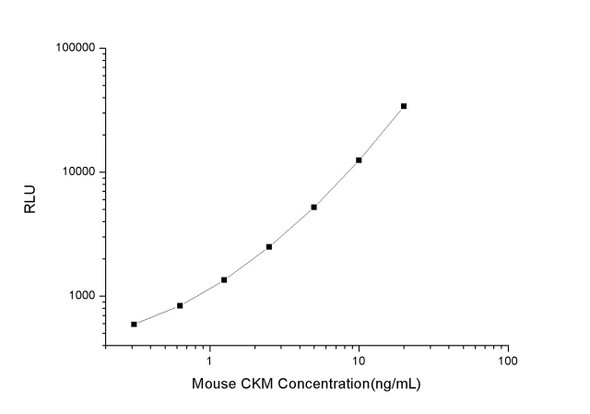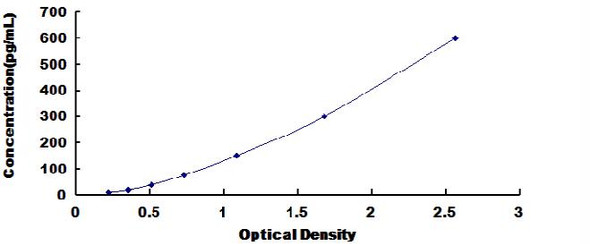Human Cell Biology ELISA Kits 5
Human CKM (Creatine Kinase, Muscle) CLIA Kit (HUES00812)
- SKU:
- HUES00812
- Product Type:
- ELISA Kit
- ELISA Type:
- CLIA Kit
- Size:
- 96 Assays
- Sensitivity:
- 0.19ng/mL
- Range:
- 0.31-20ng/mL
- ELISA Type:
- Sandwich
- Reactivity:
- Human
- Sample Type:
- Serum, plasma and other biological fluids
- Research Area:
- Cell Biology
Description
| Assay type: | Sandwich |
| Format: | 96T |
| Assay time: | 4.5h |
| Reactivity: | Human |
| Detection method: | Chemiluminescence |
| Detection range: | 0.31-20 ng/mL |
| Sensitivity: | 0.19 ng/mL |
| Sample volume: | 100µL |
| Sample type: | Serum, plasma and other biological fluids |
| Repeatability: | CV < 15% |
| Specificity: | This kit recognizes Human CKM in samples. No significant cross-reactivity or interference between Human CKM and analogues was observed. |
This kit uses Sandwich-CLIA as the method. The micro CLIA plate provided in this kit has been pre-coated with an antibody specific to Human CKM. Standards or samples are added to the appropriate micro CLIA plate wells and combined with the specific antibody. Then a biotinylated detection antibody specific for Human CKM and Avidin-Horseradish Peroxidase (HRP) conjugate are added to each micro plate well successively and incubated. Free components are washed away. The substrate solution is added to each well. Only those wells that contain Human CKM, biotinylated detection antibody and Avidin-HRP conjugate will appear fluorescence. The Relative light unit (RLU) value is measured spectrophotometrically by the Chemiluminescence immunoassay analyzer. The RLU value is positively associated with the concentration of Human CKM. The concentration of Human CKM in the samples can be calculated by comparing the RLU of the samples to the standard curve.
| UniProt Protein Function: | CKM: Reversibly catalyzes the transfer of phosphate between ATP and various phosphogens (e. g. creatine phosphate). Creatine kinase isoenzymes play a central role in energy transduction in tissues with large, fluctuating energy demands, such as skeletal muscle, heart, brain and spermatozoa. Belongs to the ATP:guanido phosphotransferase family. |
| UniProt Protein Details: | Protein type:Amino Acid Metabolism - arginine and proline; Kinase, other; EC 2. 7. 3. 2 Chromosomal Location of Human Ortholog: 19q13. 32 Cellular Component: cytosol Molecular Function:creatine kinase activity; ATP binding Biological Process: phosphocreatine biosynthetic process; phosphorylation; creatine metabolic process |
| NCBI Summary: | The protein encoded by this gene is a cytoplasmic enzyme involved in energy homeostasis and is an important serum marker for myocardial infarction. The encoded protein reversibly catalyzes the transfer of phosphate between ATP and various phosphogens such as creatine phosphate. It acts as a homodimer in striated muscle as well as in other tissues, and as a heterodimer with a similar brain isozyme in heart. The encoded protein is a member of the ATP:guanido phosphotransferase protein family. [provided by RefSeq, Jul 2008] |
| UniProt Code: | P06732 |
| NCBI GenInfo Identifier: | 125305 |
| NCBI Gene ID: | 1158 |
| NCBI Accession: | P06732. 2 |
| UniProt Secondary Accession: | P06732,Q96QL9, |
| UniProt Related Accession: | P06732 |
| Molecular Weight: | Calculated: 40kDaObserved: 43kDa |
| NCBI Full Name: | Creatine kinase M-type |
| NCBI Synonym Full Names: | creatine kinase, muscle |
| NCBI Official Symbol: | CKM |
| NCBI Official Synonym Symbols: | CKMM; M-CK |
| NCBI Protein Information: | creatine kinase M-type; creatine kinase M chain |
| UniProt Protein Name: | Creatine kinase M-type |
| UniProt Synonym Protein Names: | Creatine kinase M chain; M-CKCreatine kinase M-type, N-terminally processed |
| Protein Family: | Creatine kinase |
| UniProt Gene Name: | CKM |
| UniProt Entry Name: | KCRM_HUMAN |
As the RLU values of the standard curve may vary according to the conditions of the actual assay performance (e. g. operator, pipetting technique, washing technique or temperature effects), the operator should establish a standard curve for each test. Typical standard curve and data is provided below for reference only.
| Concentration (ng/mL) | RLU | Average | Corrected |
| 20 | 33897 34067 | 33982 | 33950 |
| 10 | 11256 13684 | 12470 | 12438 |
| 5 | 5368 5132 | 5250 | 5218 |
| 2.5 | 2518 2530 | 2524 | 2492 |
| 1.25 | 1482 1284 | 1383 | 1351 |
| 0.63 | 929 805 | 867 | 835 |
| 0.31 | 597 649 | 623 | 591 |
| 0 | 31 33 | 32 | -- |
Precision
Intra-assay Precision (Precision within an assay): 3 samples with low, mid range and high level Human CKM were tested 20 times on one plate, respectively.
Inter-assay Precision (Precision between assays): 3 samples with low, mid range and high level Human CKM were tested on 3 different plates, 20 replicates in each plate.
| Intra-assay Precision | Inter-assay Precision | |||||
| Sample | 1 | 2 | 3 | 1 | 2 | 3 |
| n | 20 | 20 | 20 | 20 | 20 | 20 |
| Mean (ng/mL) | 1.01 | 2.90 | 7.04 | 0.95 | 2.79 | 6.59 |
| Standard deviation | 0.10 | 0.29 | 0.52 | 0.08 | 0.20 | 0.52 |
| C V (%) | 9.90 | 10.00 | 7.39 | 8.42 | 7.17 | 7.89 |
Recovery
The recovery of Human CKM spiked at three different levels in samples throughout the range of the assay was evaluated in various matrices.
| Sample Type | Range (%) | Average Recovery (%) |
| Serum (n=5) | 89-105 | 96 |
| EDTA plasma (n=5) | 90-104 | 97 |
| Cell culture media (n=5) | 88-101 | 95 |
Linearity
Samples were spiked with high concentrations of Human CKM and diluted with Reference Standard & Sample Diluent to produce samples with values within the range of the assay.
| Serum (n=5) | EDTA plasma (n=5) | Cell culture media (n=5) | ||
| 1:2 | Range (%) | 99-116 | 96-110 | 100-117 |
| Average (%) | 107 | 104 | 108 | |
| 1:4 | Range (%) | 94-106 | 92-106 | 93-107 |
| Average (%) | 101 | 99 | 98 | |
| 1:8 | Range (%) | 88-99 | 89-101 | 88-99 |
| Average (%) | 94 | 96 | 93 | |
| 1:16 | Range (%) | 99-110 | 97-113 | 97-114 |
| Average (%) | 104 | 104 | 105 |
An unopened kit can be stored at 4°C for 1 month. If the kit is not used within 1 month, store the items separately according to the following conditions once the kit is received.
| Item | Specifications | Storage |
| Micro CLIA Plate(Dismountable) | 8 wells ×12 strips | -20°C, 6 months |
| Reference Standard | 2 vials | |
| Concentrated Biotinylated Detection Ab (100×) | 1 vial, 120 µL | |
| Concentrated HRP Conjugate (100×) | 1 vial, 120 µL | -20°C(shading light), 6 months |
| Reference Standard & Sample Diluent | 1 vial, 20 mL | 4°C, 6 months |
| Biotinylated Detection Ab Diluent | 1 vial, 14 mL | |
| HRP Conjugate Diluent | 1 vial, 14 mL | |
| Concentrated Wash Buffer (25×) | 1 vial, 30 mL | |
| Substrate Reagent A | 1 vial, 5 mL | 4°C (shading light) |
| Substrate Reagent B | 1 vial, 5 mL | 4°C (shading light) |
| Plate Sealer | 5 pieces | |
| Product Description | 1 copy | |
| Certificate of Analysis | 1 copy |
- Set standard, test sample and control (zero) wells on the pre-coated plate and record theirpositions. It is recommended to measure each standard and sample in duplicate. Note: addall solutions to the bottom of the plate wells while avoiding contact with the well walls. Ensuresolutions do not foam when adding to the wells.
- Aliquot 100µl of standard solutions into the standard wells.
- Add 100µl of Sample / Standard dilution buffer into the control (zero) well.
- Add 100µl of properly diluted sample (serum, plasma, tissue homogenates and otherbiological fluids. ) into test sample wells.
- Cover the plate with the sealer provided in the kit and incubate for 90 min at 37°C.
- Aspirate the liquid from each well, do not wash. Immediately add 100µL of BiotinylatedDetection Ab working solution to each well. Cover the plate with a plate seal and gently mix. Incubate for 1 hour at 37°C.
- Aspirate or decant the solution from the plate and add 350µL of wash buffer to each welland incubate for 1-2 minutes at room temperature. Aspirate the solution from each well andclap the plate on absorbent filter paper to dry. Repeat this process 3 times. Note: a microplatewasher can be used in this step and other wash steps.
- Add 100µL of HRP Conjugate working solution to each well. Cover with a plate seal andincubate for 30 min at 37°C.
- Aspirate or decant the solution from each well. Repeat the wash process for five times asconducted in step 7.
- Add 100µL of Substrate mixture solution to each well. Cover with a new plate seal andincubate for no more than 5 min at 37°C. Protect the plate from light.
- Determine the RLU value of each well immediately.






